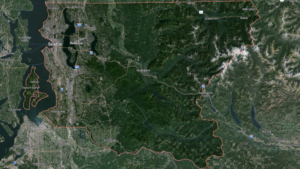After resolution of the 11th encampment from state right-of-ways in King County, 361 people have now moved inside to safe shelter and housing.
The results are impressive: 89% of the people living at encampments were successfully placed in housing and shelter that meets their needs, and, a year and a half into the initiative, 73% of the people previously at encampments are stable and remain inside.
These ongoing successful resolutions are thanks to state and local partnership, with state funding for outreach, housing, and supportive services—so that people have the stability to heal, recover, reengage in jobs and community and rebuild their lives.
The most recently resolved site was in Seattle’s University District on the eastside of I-5. Other resolved sites include Myers Way in West Seattle, Snoqualmie Street and Airport Way, Northgate, South Park, Dearborn, and the Chinatown International District.
State funding has allowed King County partners to acquire more than 240 housing units, with more than 150 additional units in the pipeline. These emergency housing and permanent housing units are non-congregate, low-barrier, not time-limited, and fully staffed by trained service providers.
In addition to the state-supported non-congregate emergency housing spaces, some people living in encampments accepted placements in existing shelters or permanent supportive housing, emergency housing with supportive services provided, and incentivized private market apartments.
To continue this work statewide, Governor Inslee has requested that the legislature approve $100 million in rapid capital acquisition funding. To ensure staffing and support services, ongoing operations funding would also be needed.
Resources Make the Difference
It’s no secret that most emergency shelters in King County are at full capacity, the supply of affordable housing is insufficient to meet demand, and many service providers are struggling to recruit and retain staff to support clientele with complex needs.
Resources that meet these needs are the key to long-term, sustainable solutions.
How does it work?
Each step in site resolution is time-intensive, labor-intensive, and necessary to succeed in moving every resident to a more permanent, safer location. Steps include:
- Outreach and engagement with people living unsheltered, often with daily presence by front-line outreach workers. Outreach is designed to build trust, connect people to health care and other services, meet basic needs like food and clothing, and ensure appropriate matching to housing and shelter.
- Building the “By Name List” to ensure that we understand the needs of our unhoused neighbors so that we can match them with services and place them in housing and shelter as soon as it becomes available.
- Site stabilization, which includes working with the City of Seattle for trash pickup and hygiene stations and working with the Washington State Department of Transportation on structural changes like fencing and vegetation removal. Teams also partner with the Seattle Police Department, Seattle Fire Department and Washington State Patrol as needed to respond to public safety issues.
- Matching people with permanent housing or temporary shelter as those resources become available.
- Reclamation and restoration of the property by WSDOT. WSDOT does a baseline of activities to include things like considerable clean-up and trash mitigation, vegetation management to increase visibility and sightlines into the property to allow for better visual monitoring in the future, fence repair and additional fence installation if needed.
Collective Action
The challenges of homelessness affect all of our communities, and it is only through partnership, collaboration and collective action that we can begin to meet the need — using best practices that look at long-term solutions.
This work is possible because of the partnership between the King County Regional Homelessness Authority, Gov. Inslee, the state legislature, the state Departments of Commerce and Transportation, the Washington State Patrol, the City of Seattle and the Seattle Police and Fire Departments, King County, our outreach partners at Purpose Dignity Action (PDA) and REACH, and housing service partners like Lifelong, Urban League, and the Low Income Housing Institute (LIHI).
Progress is not just possible, it’s happening now.
*The state Encampment Resolution Program works in five counties statewide (King, Pierce, Snohomish, Spokane and Thurton) and as of the end of 2023 had resolved 31 of 33 total sites including offering housing at each location.



